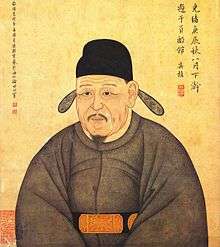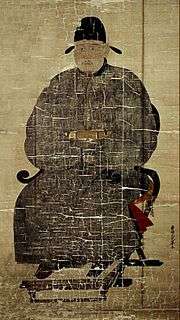Jeong Mong-ju
Jeong Mong-ju(Korean: 정몽주, Hanja: 鄭夢周, January 13, 1338 – April 26, 1392), also known by his pen name Poeun (Korean: 포은), was a prominent Korean scholar-official and diplomat during the late Goryeo period.[1][2]
| Jeong Mong-ju | |
 | |
| Korean name | |
|---|---|
| Hangul | 정몽주 |
| Hanja | 鄭夢周 |
| Revised Romanization | Jeong Mong-ju |
| McCune–Reischauer | Chŏng Mong-ju |
| Pen name | |
| Hangul | 포은 |
| Hanja | 圃隱 |
| Revised Romanization | Poeun |
| McCune–Reischauer | P'oŭn |
Biography
Jeong Mong-ju was born in Yeongcheon, Gyeongsang province to a family from the Yeonil Jeong clan. At the age of 23, he took three different civil service literary examinations (Gwageo) and received the highest marks possible on each of them.[2] In 1367, he became an instructor in Neo-Confucianism at the Gukjagam, then called Songgyungwan, whilst simultaneously holding a government position, and was a faithful public servant to King U. The king had great confidence in his wide knowledge and good judgment, and so he participated in various national projects and his scholarly works earned him great respect in the Goryeo court.
In 1372, Jeong Mong-ju visited Ming Dynasty, as a diplomatic envoy. Around the time, as Waegu (왜구/ 倭寇) (Japanese pirate)'s invasions to the Korean Peninsula were extreme, Jeong Mong-ju was dispatched as a delegate to Kyūshū in Japan, in 1377.[2][3] His negotiations led to promises of Japanese aid in defeating the pirates. He traveled to the Ming Dynasty's capital city in 1384[4] and the negotiations with the Chinese led to peace with the Ming Dynasty in 1385. He also founded an institute devoted to the theories of Confucianism.
Following a banquet held for him, Jeong Mong-ju was assassinated in 1392 by five men on the Sonjuk Bridge in Gaeseong. Politically motivated, the murder was ordered by Yi Bang-won (later Taejong of Joseon), the fifth son of Yi Seong-gye, who overthrew the Goryeo Dynasty in order to establish the Joseon Dynasty. Jeong Mong-ju was murdered because he refused to betray his loyalty to the Goryeo Dynasty. Yi Bang-won recited a poem (Hayeoga, 하여가 / 何如歌) to dissuade Jeong Mong-ju from remaining loyal to the Goryeo court, but Jeong Mong-ju answered with another poem (Dansimga, 단심가 / 丹心歌) that affirmed his loyalty. Yi Seong-gye is said to have lamented Jeong Mong-ju's death and rebuked his son because Jeong Mong-ju was a highly regarded politician by the common people. The bridge where Jeong Mong-ju was murdered, nowadays in North Korea, has now become a national monument of that country. A brown spot on one of the stones is said to be Jeong Mong-ju's bloodstain and is said to become red whenever it rains. Currently, his direct surviving descendants are his 28th and 29th generation, all of whom reside in South Korea, the United States, Canada, Portugal, Germany and the United Kingdom.
The 474-year-old Goryeo Dynasty symbolically ended with Jeong Mong-ju's death and was followed by the Joseon Dynasty for 505 years (1392-1897). Jeong Mong-ju's noble death symbolizes his faithful allegiance to the king, and he was later venerated even by Joseon monarchs. In 1517, 125 years after his death, he was canonized into Sungkyunkwan (the National Academy) alongside other Korean sages such as Yi Hwang (Toegye, 1501-1570) and Yi I (Yulgok, 1536-1584).
The 11th pattern of ITF Taekwondo is named after Poeun. The pattern is performed as part of the testing syllabus for the level of 2nd-degree black belt. The diagram ( - ) represents Jeong Mong-ju's unerring loyalty to his king and his country towards the end of the Goryeo Dynasty.
The poems

Yi Bang-won's sijo (poem) - Hayeoga (하여가, 何如歌)
이런들 어떠하리 저런들 어떠하리 此亦何如彼亦何如。 (차역하여피역하여)
만수산 드렁칡이 얽어진들 어떠하리 城隍堂後垣頹落亦何如。 (성황당후원퇴락역하여)
우리도 이같이 얽어져 백년까지 누리리라 我輩若此爲不死亦何如。 (아배약차위불사역하여)
(Based on the Hanja)
What shall it be: this or that?
The walls behind the temple of the city's deity* has fallen - shall it be this?
Or if we survive together nonetheless - shall it be that?
(* Yi Bang-won is declaring the death of the era - the Goryeo Dynasty.)
Jeong Mong-ju's sijo (poem) - Dansimga (단심가, 丹心歌)
이몸이 죽고 죽어 일백 번 고쳐 죽어 此身死了死了一百番更死了。 (차신사료사료일백번갱사료)
백골이 진토되어 넋이라도 있고 없고 白骨爲塵土魂魄有也無。 (백골위진토혼백유무야)
임 향한 일편 단심이야 가실 줄이 있으랴 向主一片丹心寧有改理也歟。 (향주일편단심유개리여)
Though I die and die again a hundred times,
That my bones turn to dust, whether my soul remains or not,
Ever loyal to my Lord, how can this red heart ever fade away?
Books
- Poeun Jip (포은집, 圃隱集)
- Poeun Sigo (포은시고, 圃隱詩藁)
In popular culture
- Portrayed by Hong Gye-il in the 1983 MBC TV series The King of Chudong Palace.
- Portrayed by Park Joon-hyuk in the 2012-2013 SBS TV series The Great Seer.
- Portrayed by Im Ho in the 2014 KBS1 TV series Jeong Do-jeon.
- Portrayed by Kim Eui-sung in the 2015 SBS TV series Six Flying Dragons.
See also
- List of Korea-related topics
- List of Goryeo people
- Korean philosophy
- Tears of the Dragon (TV series)
- Jeong Do-jeon
Notes
- Kang et al. (2006), p. 191.
- 정몽주 鄭夢周 Archived 2011-06-10 at the Wayback Machine (in Korean) Nate / Encyclopedia of Korean Culture
- Titsingh, (1834). p. 313.
- Kang, p. 159.
References
- Kang, Jae-eun; Lee, Suzanne (translator). (2006). The Land of Scholars: Two Thousand Years of Korean Confucianism. Paramus, New Jersey: Homa & Sekey Books. ISBN 978-1-931-90737-8; OCLC 60931394
- Titsingh, Isaac. (1834). Annales des empereurs du Japon (Nihon Ōdai Ichiran). Paris: Oriental Translation Fund of Great Britain and Ireland. OCLC 84067437
| Wikimedia Commons has media related to Jeong Mongju. |